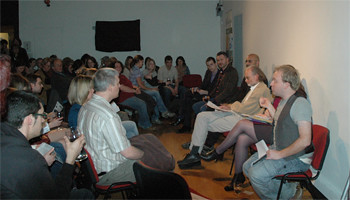The following is an essay written by Dr. Rebecca Williams and relates to the film Warm Bodies which preceded a Cardiff sciSCREEN on
Friday May 17th.
Whilst the vampire was, for a time, the
most popular horror archetype in popular media and culture (see Twilight, True Blood, The Vampire Diaries and more), it is the
figure of the zombie who has undergone the most recent transformation from a
figure often at the periphery of contemporary horror to one of the key tropes
seen across a range of texts. Whilst zombies have featured in horror films including
The Evil Dead, 28 Days and 28 Weeks Later, the Spanish Rec series and its English-language
remake Quarantine and George A.
Romero’s numerous zombie movies (as well as the more parodic Zombieland and Shaun of the Dead) it is in the last few years that they have
achieved a more central place in contemporary media texts. From the literary
rewriting of Austen’s Pride &
Prejudice to include zombies, the success of AMC’s Walking Dead adaptation, to the best-selling World War Z (soon to be a film starring Brad Pitt), and the
popularity of so-called zombie walks where people dress up and ‘become’
zombies, the zombie has clearly shuffled onto centre stage across literature,
television and film. Why has this been the case when, for some time, zombies
appeared to be the poor relation to the altogether more attractive and
intriguing figure of the vampire? Whilst vampires could easily be portrayed as
sympathetic and alluring, the zombie’s apparent inability to communicate, its
lack of intellect, rationality or emotion, and its oft-commented on lack of
speed, seemed to render the zombie a less captivating prospect for exploration.
The idea that one might appear sympathetic and as a romantic figure, as in Warm Bodies, certainly seemed unlikely.
On a broader scale, zombie films have
been seen as a representation of forms of ideology. They have, according to
Peter Dendle, served “as an abstract thought experiment – projected at first
into religion, folklore and then eventually into film, fiction, visual arts and
electronic media – for meditation what it means to be “human”” (2011:176-7).
For example, in his book American Zombie
Gothic, Kyle William Bishop notes that “each of [George] Romero’s zombie
films provides deliberate social and cultural criticism, using the zombies and
the situations they create as allegories about the perils of modern life”
(2010:202). For example, Romero’s comments on race and capitalism in Night of the Living Dead and Dawn of the Dead, respectively, as well
as his more recent films Land of the Dead
(dealing with terrorism) and Diary of the
Dead which deals with the impact of media culture, 24 hour news, streaming
of online content and so on. Similarly, films such as Rec and Quarantine or 28 Weeks Later have been read as tapping
into contemporary fears around biological warfare and the possibility of
post-9/11 potential terrorist attacks involving contagion.
There are also more personal reasons for the endurance of the zombie. Horror has always been fascinated with the idea of crossing between borders and boundaries; ghosts, vampires and werewolves are clear examples of this. Peter Dendle notes that “The zombie is a creature of paradox. It is at once familiar and alien, alive and dead, human and non-human” (2011:174). As a ‘living corpse’ the zombie in its original form offers an example of a creature that crosses the boundary between the living and the dead, between the human and non-human, acting as a horrific reminder of our own mortality. The figure of the zombie also offers the possibility for rumination on the notion of the human soul; whilst the ghost offers a “disembodied soul”, the “zombie is the opposite of such as “ghost”: it is a soulless body” (Dendle 2011:177) and, therefore, frequently coded as more dangerous and destructive than the often more benevolent ghost.
Film theorist Barbara Creed has argued
that the corpse becomes drawn on in the horror genre since it can represent
what she refers to as the abomination of the dead body by showing the abjection
of the decaying body. This can be seen in early representations of zombies such
as The Evil Dead or Night of the Living Dead and its
follow-ups. However, aside from their ability to visually and graphically
depict the decay of the dead body, figures such as the zombie also have the
potential to allow viewers to question their own mortality and a range of
existential issues. As Creed notes, the horror genre offers monsters who allow
us to ask “Where did I come from? Where am I going?” (1993:154) and to reflect
in a more serious manner on questions about what happens after death. The
insistence of several human characters in zombie films that they be ‘put down’
or killed if they are to turn into zombies themselves also offers a chance for
some reflection on what it means to be alive or dead, or somewhere
‘in-between’.
Such questions are more central to more
contemporary zombie narratives than to the decaying and disintegrating bodies
of the zombies seen in Romero’s films and other representations. Bishop notes that “recent developments in the
subgenre have begun to bestow more personality, subjectivity, and even humanity
upon the zombie” (2010:158). Much like the vampire has been reimaged as a
tragic loner, as a romantic and misunderstood hero, Warm Bodies offers a more sympathetic look at the zombie. What, it
asks us, is it like for a young man who is also undead? How might a relationship
between a human girl and a zombie work out? In presenting a romantic story
featuring a zombie character (whilst Shaun
of the Dead was billed as a rom-zom-com, neither of the romantic leads was
themselves, dead) the film draws on dynamics set up in countless vampire
narratives such as Buffy, Twilight, True
Blood and The Vampire Diaries
where human women falls in love with a vampiric suitor. Warm Bodies is also interesting in that the point of view is always
with the zombie character ‘R’ - his desire for eating human brains is also
presented in as romantic a light as it can be – the experience of consuming
other people’s memories and emotions allows a temporary feeling of being
‘alive’, of a sense of connection. As Isaac Marion, the writer of the original
short online story I Am a Zombie Filled With Love, notes, “As I was figuring out the
story, it lined up with a lot of feelings I was having at that time in my life.
It was actually about my experience with the world and trying to figure out who
I am. It was trying to establish a connection to the rest of society and
humanity.” R’s attempts to connect with others thus functions as a point of
relation; viewers can thus empathise with this common experience. As he states
at the start of the film, “I just want to connect”.
Portraying R as a sympathetic character is also made possible by the presence of something worse than zombies within the narrative. Whilst zombies in the film are undead and prone to eating humans, they are not the worst thing that the post-apocalyptic world has to offer here; worse are the so-called ‘Bonies’ who have removed their own flesh, existing as skeletal forms who are equally happy to kill zombies as they are human. In allowing the Bonies to be the “real” horror in the film, the zombie characters appear more human in contrast; encouraging identification and empathy rather than terror and fear.
Thus, as zombie narratives
become more complex, “audiences are being asked to relate to the zombies in a
more direct way; instead of simply seeing their own potential death in the
familiar visages of the walking dead foes, viewers are being encouraged to
sympathise with the zombies, recognising them as fully realized individual
characters and even rooting for them in their narrative plights” (2010:167).
Bishop is talking about Romero’s Land of
the Dead here, but this can equally be applied to the case of Warm Bodies which offers a representation
of zombies as more nuanced, benevolent and offers more rounded
characterisation.
There are, however, clear commercial
imperatives to the ongoing success, and reinvention of the zombie film.
Ideology is not the only way of understand the cinematic zombie revolution –
the film industry is always looking for new ways to attract audiences with a
twist on a popular idea and what better to try to lure in a Twilight-loving audience than with a
zombie love story? It is interesting that the same company that produced Twilight – Summit Entertainment – are
also responsible for bringing Warm Bodies
to the big screen. Zombies are clearly big business. However, we cannot overlook
the fact that the zombie has endured as a figure of fascination since the early
days of cinema and with further transformation will continue to do so. After
all, as Paffenroth notes, “zombie movies will constantly have to change and
adapt if they are to remain a powerful and popular force in the future”
(2006:133).
Bishop, Kyle William (2010) American
Zombie Gothic: The Rise and Fall (and Rise) of the Walking Dead in Popular
Culture, Jefferson, North Carolina: McFarland.
Creed, Barbara (1993) The Monstrous-Feminine, London: Routledge.
Dendle, Peter (2011) ‘ Zombie movies and the “millennial generation”’,
in Deborah Christie and Sarah Juliet Lauro (ed.) Better Off Dead: The Evolution of the Zombie as Post-Human, New York: Fordham University
Press, pp 175- 186.
Paffenroth, Kim (2006) Gospel of
the Living Dead: George Romero’s Visions of Hell on Earth, Waco: Baylor University Press.











No comments:
Post a Comment